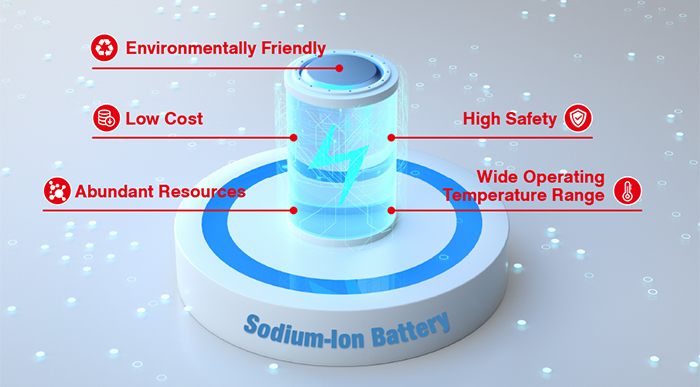As global energy demand continues to grow, the use of renewable energy and grid peak shaving have become critical energy strategies. Large-capacity sodium-ion battery energy storage systems, as an emerging energy storage technology, offer advantages such as low cost, high safety, and long life. These systems are poised to play a significant role in various fields such as power, transportation, and communications. This article will introduce the research background, technological advancements, and application prospects of large-capacity sodium-ion battery energy storage systems in China’s energy transition.
1. Research Background
In recent years, renewable energy sources such as wind and solar have been widely used globally. However, the volatility and intermittency of these energy sources pose challenges to the stable operation of the power grid. To address this issue, energy storage technology has become key. Traditional lithium-ion battery storage technology has achieved some success but is limited by high costs and resource constraints. Therefore, there is an urgent need for a low-cost, resource-rich storage technology. Sodium-ion batteries, as a promising alternative, have attracted widespread attention.
2. Technological Advancements and Advantages
Research on large-capacity sodium-ion battery storage systems focuses mainly on anode and cathode materials, electrolytes, and separators. Significant progress has been made with hard carbon anode materials and layered oxide cathode materials. On April 6th, the Guangxi Power Grid Company of China Southern Power Grid, in collaboration with China Southern Power Grid Energy Storage Co., Ltd., and the Institute of Physics of the Chinese Academy of Sciences, successfully developed a long-life, wide-temperature, high-safety sodium-ion storage battery, leading to the creation of China’s first large-capacity sodium-ion battery energy storage system, which meets international standards.
Sodium-ion battery storage systems have several advantages but also face technical challenges:

Abundant Resources: Sodium is much more abundant in the Earth’s crust than lithium, making raw materials for sodium-ion batteries cost-effective.
Low Cost: Due to the abundance of sodium, sodium-ion batteries are relatively low-cost, potentially reducing overall costs in large-scale storage applications.
Environmentally Friendly: The manufacturing process of sodium-ion batteries is relatively environmentally friendly, and they do not produce harmful substances during use, contributing to environmental protection.
High Safety: Sodium-ion batteries perform well under extreme conditions such as overcharging, over-discharging, and short circuits, reducing the risk of thermal runaway and fires.
Wide Operating Temperature Range: Sodium-ion batteries maintain good performance even in low-temperature environments, suitable for use in various climates.
3. Technical Challenges
Energy Density: Currently, sodium-ion batteries have a lower energy density compared to lithium-ion batteries, limiting their use in high energy density applications such as long-range electric vehicles.
Material Selection and Optimization: Choosing and optimizing cathode and anode materials and electrolytes is key to improving sodium-ion battery performance. Finding high-stability, high-capacity electrode materials remains a research focus.
Cycle Life: The cycle stability and lifespan of sodium-ion batteries need improvement compared to lithium-ion batteries, especially for fast charging and discharging applications.
Safety and Stability: Although sodium-ion batteries have safety advantages, their stability and safety under high temperatures and humid conditions need further research and enhancement.
Manufacturing Process: The large-scale manufacturing process for sodium-ion batteries is still immature, requiring the development of efficient, controllable production techniques and equipment.
Standardization and Testing Systems: As an emerging storage technology, sodium-ion batteries lack unified standards and testing systems, limiting their market promotion and application.
4. Application Prospects
Under the backdrop of China’s energy transition, large-capacity sodium-ion battery energy storage systems have broad application prospects. In the power sector, these systems can be used for grid peak shaving and renewable energy generation, improving grid efficiency and renewable energy utilization. In transportation, sodium-ion batteries can power electric vehicles, promoting their adoption. Additionally, in communications and data centers, sodium-ion battery storage systems can serve as backup power sources, enhancing system reliability.
5. Conclusion
Large-capacity sodium-ion battery energy storage systems, with their low cost, high safety, and long lifespan, will play a crucial role in China’s energy transition. Future research should continue to optimize material performance, enhance the intelligence of battery management systems, and reduce costs. It is believed that in the near future, large-capacity sodium-ion battery energy storage systems will usher in a new era of efficient energy storage.







